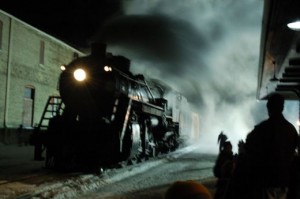 On a rainy and foggy night, a man named Joe Baldwin was working on the train rails along the Wilmington and Manchester railroad. He discovered the car was separated as a train was coming. He knew another train was approaching, so he dashed to the platform. He signaled the train with his lantern. Baldwin was decapitated in the collision because the engineer never saw him. Some claim that the head was never discovered.
On a rainy and foggy night, a man named Joe Baldwin was working on the train rails along the Wilmington and Manchester railroad. He discovered the car was separated as a train was coming. He knew another train was approaching, so he dashed to the platform. He signaled the train with his lantern. Baldwin was decapitated in the collision because the engineer never saw him. Some claim that the head was never discovered.
After a while, people reported seeing a weird light on misty evenings and hearing boots squeak down the track where Baldwin was killed. It has even caused delays for trains arriving from other stations. Some believe it’s merely local swamp fog mixed with highway light, but others have a different perspective. Is Joe Baldwin genuinely on the lookout for his head? I’m not sure, but are you willing to find out?

Parker from Whiteville, North Carolina
More information about the story of the Mako Light
The light was linked to Joe Baldwin, a train conductor who was supposed to have been beheaded in a late-nineteenth-century collision between a speeding passenger car and a locomotive at Maco, on the Wilmington and Manchester Railroad.
Joe Baldwin was the solitary occupant of the rear car of a Wilmington-bound train on a rainy night in 1867, according to the most popular version of the legend. Baldwin saw the car had become detached from the rest of the train. He was aware that another train was approaching, so he dashed to the rear platform and furiously waved a light to warn the approaching train. Baldwin was decapitated in the crash because the engineer failed to notice the stalled train car in time. Baldwin’s head was never found, according to some versions of the story.
Residents of Maco and railroad workers reported seeing a white light along a section of railroad track through wetlands west of Maco station shortly after the accident, and word circulated that Joe Baldwin had returned to look for his missing head. The light was stated to appear in the distance before approaching the Eastbound tracks, bobbing at a height of around 5 feet and either flying to the side of the track in an arc or receding from the viewer. Different reports mentioned green or red lights, as well as other movement patterns. The first reports originate from the 1870s, and until the 1886 Charleston earthquake, two lights were frequently reported: railroad employees claimed that trains had been stopped or delayed because of the light, which had even been seen from locomotive cabs.
In 1946, the journal Railroad Telegrapher stated that the light had been observed on March 3rd of that year, and that it had been seen for at least seventy years. Robert Scott, editor of the Atlantic Coast Line News, gave another early account of the Joe Baldwin legend to the journal Railway Age in 1932. Similar “headless brakeman” stories have been found associated with other “ghost lights” in the US, such as the Bragg Road ghost light and the Gurdon light: from a folklore perspective, the story associated with the Maco light, being the oldest and best-known and having received some national coverage, may have served as the point of origin for the others.
A similar story is called The Black Ghost
In 1899, a man named Richard Radcliff was walking home from work. He came upon the train gate that signaled green, but the signal was faulty and a steam locomotive came rushing down the tracks and swept him away, ending his life before he could scramble to safety. When his body was recovered it was covered with oil and ash, but amazingly it was still intact. Afterward, people from the railroad company reported seeing him walking along the side of tracks near the same signal box. He would whistle the tune of I’ve Been Working on the Railroad. When he finished the tune he would snap his fingers twice and the signal box would break again. From that day forward they called him the black ghost

Declan Bray from South Abington Twp.
